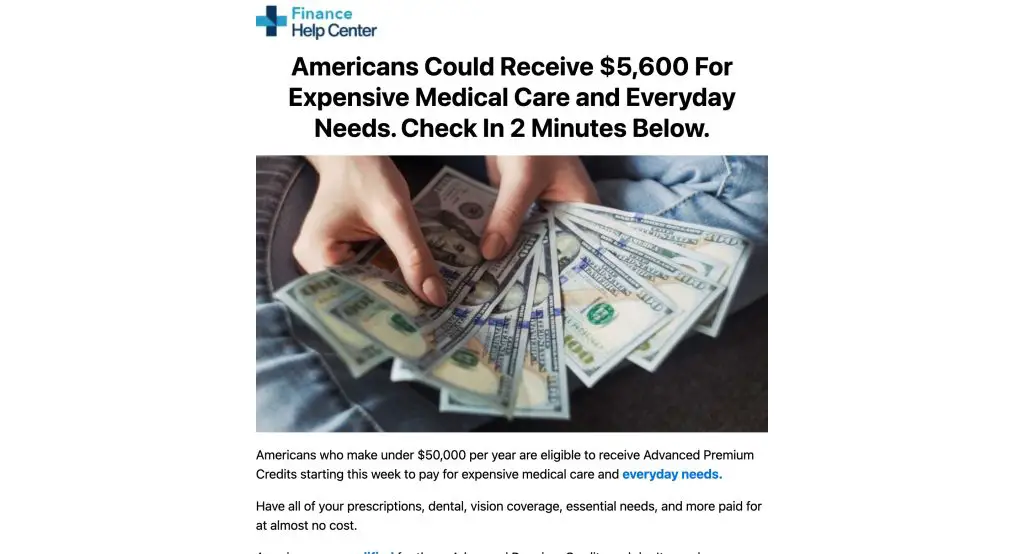Subsidyapprovals.com Scam: Fake Subsidy Benefits! Don’t Fall Victim
The subsidyapprovals.com is not legit at all but an elaborate scam trending on Youtube claiming that the United States government is giving $5,400 subsidies through the Inflation Reduction Act. It’s a scam!!.
If you see an ad offering free money or subsidy, do not click on it at all. It is made in such a way that it looks legitimate and real. However, all this is part of a scam to steal money from innocent citizens.
As a Cybersecurity analyst, I’ve taken my time to investigate the claims made by Subsidyapprovals.com. This article sheds a light on how the scam operates, and all you need to know.

A Close Look at Subsidyapprovals.com
Subsidyapprovals.com runs Ads on Social media -especially YouTube – with a click bait. ‘Americans Could Receive $5,600 For Expensive Medical Care and Everyday Needs’
The ad states they want no personal information about you and that the government is handing out $5600/month if you’re not on Medicaid/Medicare.
Of course, the subsidy is totally fake. The Ads direct you to the website were you fill a form after answering some survey questions.
Exposing How The Subsidy Scam Works
After answering a few questions, they will tell you that you qualify for the benefits of the subsidy and need to call phone number to claim it. This is where the scam comes in. The person on the other end of the phone is a scammer looking to trick people into inadvertently sharing their sensitive data like personal and financial info.
The scammers would then proceed to use it for fraudulent purposes. In some case, they sell it to the dark web. Of course, there’s really subsidy to be claimed. The website isn’t from the government or linked to any official health program. Cash subsidies from the government usually have conditions and aren’t assured.
Where to Get Real Financial Assistance from the Government
If you need financial help with living expenses or business costs, you can check out these legitimate government assistance programs:
- Benefits.gov: They offer support for things like food, housing, healthcare, childcare, Social Security, and more.
- GovLoans.gov: This site provides assistance for small businesses, education, housing, and other needs.
- Grants.gov: It’s mainly for organizations involved in government-funded projects, not for individuals or personal expenses.
Here are Some Signs Of A Fake Subsidy Offer:
- It’s new: The website just started operating recently, so it doesn’t have much history.
- Unrealistic promises: They claim to cover all medical expenses for people earning under $50,000, which sounds too good to be true.
- Seems fishy: Offering thousands of dollars in financial assistance for everyday expenses isn’t something government programs usually do.
- Not thorough: They don’t seem to check if you’re actually eligible for the benefits they promise.
- Asking for too much: They want you to give them a lot of personal information without any clear guarantee that you’ll actually get anything in return.
- If you hear about “free government money” that sounds too good to be true and doesn’t have any proof, it’s probably not real. Don’t fall for it.
- If you can’t find real reviews from people who actually got the subsidies on official or popular websites, be cautious. It might be a scam.
What To Do If You’re a Victim of The Subsidyapprovals.com Scam
- Stop talking to the scammers.
- Tell the police or report the scam to the government. In the U.S., you can report it to the Federal Trade Commission (FTC) online.
- If you gave them your money details, tell your bank or credit card company. They can help keep your accounts safe.
- Warn your friends and family about what happened so they don’t fall for the same trick.
Conclusion
Finally. We couldn’t find any news or official government announcements about giving away $5,400 or changing the Inflation Reduction Act, which became law in 2022.
The government warns that offers of free money or grants are often scams. Legitimate financial help comes from official government websites. You can find tips on avoiding these scams and where to report them on the Federal Trade Commission’s website.
There is also a new scam posing as the U. S government to offer subsidy benefits to Americans, $6,400 Subsidy Scam, Relief Guru Center.
